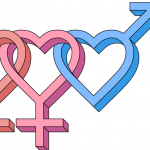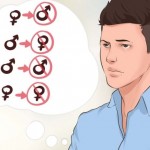Sexuality, gender and identity are all things that are people are trying to learn about more and more in this day and age. It is becoming increasingly important to talk about people’s choices, preferences, and sexual orientation, in order to respect the boundaries of the people we communicate with, and understand where and what they are comfortable with. Previously, homosexuality and heterosexuality encompassed the nature of all relationships, but now, concepts like bisexuality, trans-sexuality, intersexuality, pansexuality, and asexuality are all part of the discussion, including the other various sexual orientations that people identify with. Despite the recognition of these various aspects of sexuality, people still struggle to understand some of the more subtle differences between categories, such as the difference between aromantic and asexual.

Image source: Shutterstock
Several people are part of a community which identifies itself as asexual, but few are aware of a community of people who are also aromantic. In order to understand the difference between the two, first let us look at their respective definitions.
Suggested read: What The Dating World Looks Like To An Asexual Person
The definition of asexual (according to Merriam-Webster) is as follows:
a : not involving, involved with, or relating to sex : devoid of sexuality
- an asexual relationship
b : not having sexual feelings toward others : not experiencing sexual desire or attraction
-
In general, an asexualperson does not feel or otherwise experience any sexual attraction, according to The Asexual Visibility & Education Network (AVEN). Basically, it is an inborn absence of sexual desire.
—Lindsay E. Mack
The definition of aromantic (according to AVENwiki) is as follows:
An aromantic is a person who experiences little or no romantic attraction to others. Where romantic people have an emotional need to be with another person in a romantic relationship, aromantics are often satisfied with friendships and other non-romantic relationships.

Image source: Pixabay, under Creative Commons License
Therefore, while a person who identifies as asexual doesn’t develop sexual feelings, an aromantic person is unable to develop a romantically motivated emotional connection with a person. This is the primary difference between an aromantic and asexual person. Let us delve a little further into the issue.
Misunderstandings regarding sexuality and preferences are more common than empathy or sympathy regarding these matters. This is why misconceptions are rife when it comes to discussing anything other than homosexuality or heterosexuality. I am going to address a few common myths regarding asexuality and aromanticism, for you to better understand what these two concepts are, and more importantly, what these two concepts are not.
5 Myths About Asexuality
1. Asexual people are celibate
This is the first common misconception regarding asexuality. As the definition above says, asexuality is a complete lack of sexual attraction that people feel for other people. It is the lack of attraction, or the lack of wanting to have sex, which qualifies a person as asexual.
That does not, however, mean that asexual people don’t want to have sex. Asexual people do have sex, but not out of a desire to have sex. Some asexual people are completely repulsed by the idea of intercourse, but most have a very neutral attitude towards it and don’t think it is vital or indispensable to a successful and mutually rewarding relationship.
2. Asexuality is a medical condition

Image source: Pixabay, under Creative Commons License
It is a common misconception to think that asexuality can be pathologized and treated medically. This was how homosexuality and bisexuality were treated, up until the end of the 20th century. Asexuality, like bisexuality and homosexuality, is product of how one’s body is wired, and not something that can be “treated” with science and medicine.
In fact, some of the more pressing problems for asexuality are loneliness, depression, stress and anxiety, all of which are serious psychological conditions that have to be medically treated. However, asexual people are often subjected to physical treatment for their inability to feel sexual attraction, which is just wrong.
3. Asexual people don’t have genitals
One of the worst possible myths about asexuality is the fact that people refuse to believe that asexual people have genitalia. Most people don’t like talking about this outright, but those who are comfortable with discussing this, have trouble coming to terms with the fact that asexual people also have sex and children.
This also addresses a larger problem, where popular mindset equates sex with gender, and is so obsessed with people’s genitals. It is distressing not only for asexual people, but also those who are bi, intersex or gay.
Suggested read: 12 Struggles Of Being An Asexual Person
4. All asexual people are aromantic
Those who do not understand the concept of asexuality completely, and have trouble coming to terms with the whole idea of aromanticism might feel that the two terms are inter-changeable. This could not be further from the truth. Asexual people can also have romantic relationships with other people. This misconception stems from a very strange notion that people cannot have fulfilling relationships without sex, which isn’t the case at all.
While sex is an important part of a relationship, it is not an indispensible part, which means asexual people can also have romantic relationships without wanting to constantly have sex with their partners. It is simply a situation where they don’t feel the need to have sex with their partners, which again, does not imply that they cannot have sex.
5. Asexual people don’t belong to the LGBTQIA community

Image source: Google, copyright-free image, under Creative Commons License
The LGBTQIA community is about giving people a space where they can be themselves. It is about exercising your choices without judgment or fear. However, a lot of people don’t like to include asexual people in this community, because they don’t have a sexual preference at all. Asexual people are devoid of any feelings regarding sex, which is why they aren’t usually included in a community which contains people with alternative sexual preferences. However, being asexual is also a sexual preference, and contrary to popular believe, the “A” in LGBTQIA doesn’t stand for ally, and in fact, strands for asexual, aromantic or agender.
5 Myths About Aromanticism
Now that we have learnt quite a lot about asexuality and asexual people, here are a few popular myths about aromantics, which could help you understand the community better.
1. All aromantics are asexual
It is imperative to understand that romantic feelings have nothing to do with sex. Sex is a purely physical sensation, while romance is more to do with emotions and feelings. An aromantic is an individual who doesn’t feel the need to engage in a romantic relationship, which means that they don’t adhere to the conventional notions of love and relationships. They don’t feel the need to have someone they can exclusively call their partner.
People can have sexual relationships with people they don’t love, which is true for romantics as well. However, an aromantic is biologically unable to feel romantic feelings for another person, and all the various aspects of a relationship, such as support, trust, emotional validation, etc. are fulfilled via platonic connections.
2. Aromantics don’t have exclusive partners

Image source: Pixabay, under Creative Commons License
It is true that aromantics don’t have romantic partners that they are with exclusively, however, that doesn’t imply that they don’t have partners at all. Aromantics are people who expect certain things from the connections in their lives, except they just don’t crave for the romantic kind of affection.
Aromantics can be asexual, in which case they search for a person with whom they can share an exclusive friendship, without any of the nuances of a typical romantic relationship, and without sex. However, there are also sexual aromantics, who can have a physical relationship with someone they are emotionally close to, without feeling the conventional romantic feelings for them.
3. Aromantics don’t love anyone
A common misconception about aromantic people is that just because they are unable to feel romantic feelings for someone, they are cold, heartless creatures who cannot love anyone. In reality, aromantics are perfectly capable of feeling the platonic kind of love for their friends and family and anything else, just like others. Aromanticism is a very minor part of the hormones which control the way you feel about people and things.
4. Aromantic people hate sex
Feeling romance has nothing to do with craving sex. Just like asexual people are perfectly capable of loving someone without wanting to have sex with them, aromantics can want to have sex with people, without developing feelings for them. This myth again, stems from the fact that people correlate love with sex, and are unable to understand the two have two different sources, and are not inter-changeable terms. Aromantics can be asexual, but they can also be transsexual, bisexual, pansexual, intersexual and heterosexual, without having to engage in a serious relationship with any of their partners.
Suggested read: 12 Important Things I Learnt From Falling In And Out Of Love
5. Aromantics don’t exist

Image source: Pixabay, under Creative Commons License
Most people refuse to acknowledge the very existence of aromantics. The term is often dismissed, because people are under the impression that aromantics are cynics, misguided, mentally ill, sociopaths, introverts, slutty, or simply people who have not met their “soul mates” yet.
The pressure to conform to a normative format when it comes to relationships, where one person must love another person the way most of the population does it, is an added pressure on the aromantic community, and it questions their very existence.
Understanding the difference between an aromantic and asexual is important for the people who belong to those communities, because they are our friends, and our family, and the better we understand them, the more inclusive our community can become.
Featured image source: Shutterstock













